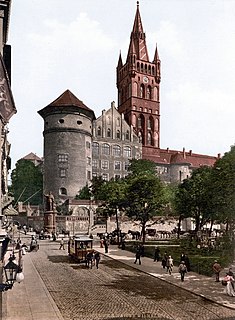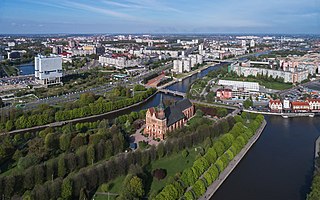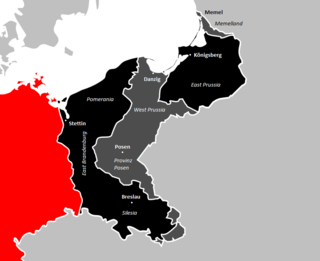

Rosenau was first a suburb of and then a quarter of Königsberg, Germany, located south of the city center. Its territory is now part of the Moskovsky District of Kaliningrad, Russia.
A quarter is a section of an urban settlement.

Königsberg is the name for a former German city that is now Kaliningrad, Russia. Originally a Sambian or Old Prussian city, it later belonged to the State of the Teutonic Order, the Duchy of Prussia, the Kingdom of Prussia, the German Empire, the Weimar Republic and Nazi Germany until 1945. After being largely destroyed in World War II by Allied bombing and Soviet forces and annexed by the Soviet Union thereafter, the city was renamed Kaliningrad. Few traces of the former Königsberg remain today.

Germany, officially the Federal Republic of Germany, is a country in Central and Western Europe, lying between the Baltic and North Seas to the north, and the Alps to the south. It borders Denmark to the north, Poland and the Czech Republic to the east, Austria and Switzerland to the south, France to the southwest, and Luxembourg, Belgium and the Netherlands to the west.
The estate Rosenau, originally known as Kneiphöfischer Ratshof in comparison to Altstädtischer Ratshof, was sold by Hans Simon of Aweiden to the council of Kneiphof in 1540. [1] The estate was worked by farmers from Schönfliess and Nasser Garten. [2]

Ratshof or Rathshof was a suburban quarter of western Königsberg, Germany. Its territory is now part of the Tsentralny District of Kaliningrad, Russia.
Aweiden or Aweyden was first a suburb of and then a quarter of Königsberg, Germany, located south of the city center. Its territory is now part of the Moskovsky District of Kaliningrad, Russia.

Kneiphof was a quarter of central Königsberg, Germany. During the Middle Ages it was one of the three towns that composed the city of Königsberg, the others being Altstadt and Löbenicht. The town was located on a 10-hectare (25-acre) island of the same name in the Pregel River and included Königsberg Cathedral and the original campus of the University of Königsberg. Its territory is now part of the Moskovsky District of Kaliningrad, Russia.
The last owners of the estate were the Schulte-Heuthaus family. Rosenau was incorporated into Königsberg in 1908. [3] It was connected to Mühlenhof to the north and Speichersdorf to the south by Aweider Allee. Ponarth was to the west. The Sportplatz am Friedländer Tor was a stadium located to Rosenau's northwest.
Mühlenhof was first a suburb of and then a quarter of Königsberg, Germany, located southeast of the city center. Its territory is now part of the Moskovsky District of Kaliningrad, Russia.
Speichersdorf was first a suburb of and then a quarter of Königsberg, Germany, located south of the city center. Its territory is now part of the Moskovsky District of Kaliningrad, Russia.

Dimitrovo is part of the Moskovsky District of Kaliningrad, Russia. Until 1947, it was known by its German language name Ponarth as first a suburb of and then a quarter of Königsberg, Germany, located southwest of the city center.
Rosenau developed into a working class suburb after Königsberg was connected to the railroad. In 1895, the Königsberg building councillor Mühlbach led the construction of the Schlacht- und Viehhof, a modern slaughterhouse. [4] From 1905-06 it was expanded further. Hugo Stinnes founded the Odinwerk, one of the largest factories and foundries of eastern Germany. [5] Rosenau Church served as the quarter's Protestant church.

The Prussian Eastern Railway was the railway in the eastern Kingdom of Prussia until 1918. Its main route, approximately 740 kilometers (460 mi) long, connected the capital, Berlin, with the cities of Danzig (Gdańsk) and Königsberg (Kaliningrad). At Eydtkuhnen (Chernyshevskoye) it reached the German Empire's border with the Russian Empire. The first part of the line opened in 1851, reaching Eydtkuhnen in 1860. By March 1880 the total route length reached 2,210 kilometers (1,370 mi), with a main parallel route in the south via Bromberg (Bydgoszcz) and Thorn (Toruń) to Insterburg (Chernyakhovsk). The lines were the first part of the later Prussian State Railways.

Hugo Dieter Stinnes was a German industrialist and politician.

The former eastern territories of Germany are those provinces or regions east of the current eastern border of Germany which were lost by Germany after World War I and then World War II.



